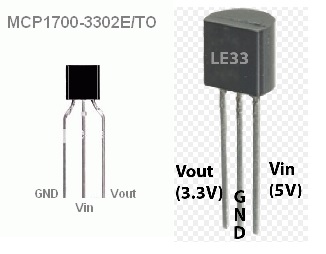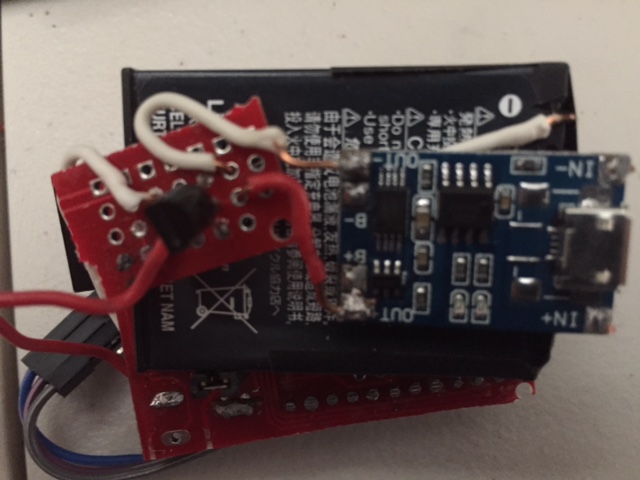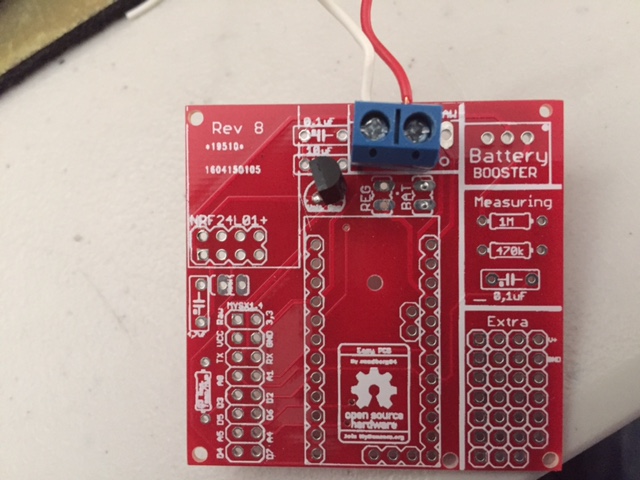💬 Easy/Newbie PCB for MySensors
-
I managed to change my PCB order, I saw that one of the updates to rev9 was the ability to use Pin 2 as GPIO instead of going to the Radio where it is unused. So now I have a order for Rev9 instead.
I will try to desolder the led or resistor and the voltageregulator.
Thanks for sharing your design.
@popunonkok Good luck - let me know if there is any other questions.
-
So a question I have always wondered about the voltage regulator is do you really need to desolder it if you connect your incoming power to the 3.3v pin and not the RAW pin? I would have thought the regulator would only drain power if it was converting the RAW power down to 3.3v.
@dbemowsk in fact current is leaking through the regulator when its input is floating, you can check the "reverse leakage current" value on the data sheet of the linear regulator used on your promini boards then decide if you can accept it or not, depending on your circuit.
-
Hi -
I wanted to know if this config is OK:
Attach a LIPO battery to PWR and GND.
Cut off the right side of the board.
Use a 3.3V pro mini.
Add a regulator (like a MCP1700) and necessary caps. (Spec says 1uF).The idea is that the board and sensors get 3.2V - 4.1 V (which should be OK).
The radio gets 3.3V.Thanks!
-
Hi -
I wanted to know if this config is OK:
Attach a LIPO battery to PWR and GND.
Cut off the right side of the board.
Use a 3.3V pro mini.
Add a regulator (like a MCP1700) and necessary caps. (Spec says 1uF).The idea is that the board and sensors get 3.2V - 4.1 V (which should be OK).
The radio gets 3.3V.Thanks!
@ileneken3 - sounds right, you should short the jumper REG which will feed everything the LIPO voltage. If this is higher than 3.3v I dont know what will happen but adding the voltage regulator for the radio will make sure that one is ok. I dont know about the pro mini, it it can handle up to 4.1v but I guess you will find out.
-
No problem with the promini. Limit is from atmega and it's 5.5V I think (at least 5V anyway :) )
You will just have HIGH level voltage at battery voltage at the outputs instead of 3.3V -
So technically you can power a 3.3V pro mini with a LiPo battery, you only need a regulator for radio, correct? Can you still make reliable battery voltage measurement? I Have a NRF24 adapter with a AMS1117 onboard, will that still work or does it need 5v?
-
So technically you can power a 3.3V pro mini with a LiPo battery, you only need a regulator for radio, correct? Can you still make reliable battery voltage measurement? I Have a NRF24 adapter with a AMS1117 onboard, will that still work or does it need 5v?
@gohan said in 💬 Easy/Newbie PCB for MySensors:
So technically you can power a 3.3V pro mini with a LiPo battery, you only need a regulator for radio, correct?
Correct.
Can you still make reliable battery voltage measurement?
I Have a NRF24 adapter with a AMS1117 onboard, will that still work or does it need 5v?
From the datasheet typical dropout voltage is 1.1V and it can be up to 1.3V.
So to get 3.3V at the output you need at least 3.3 + 1.1 = 4.4V. It won't work with your battery, you need to use another voltage regulator with a much lower dropout voltage. -
@gohan said in 💬 Easy/Newbie PCB for MySensors:
So technically you can power a 3.3V pro mini with a LiPo battery, you only need a regulator for radio, correct?
Correct.
Can you still make reliable battery voltage measurement?
I Have a NRF24 adapter with a AMS1117 onboard, will that still work or does it need 5v?
From the datasheet typical dropout voltage is 1.1V and it can be up to 1.3V.
So to get 3.3V at the output you need at least 3.3 + 1.1 = 4.4V. It won't work with your battery, you need to use another voltage regulator with a much lower dropout voltage. -
I have seen these boost/buck converters https://www.aliexpress.com/store/product/5pcs-mini-1-8V-3V-3-7V-5V-to-3-3V-Boost-Buck-Low-Noise-Regulated/1525466_32365767349.html
Would they make any sense to use with LiPo batteries or other solar power source to power a node? Or would they waste too much energy?
-
At least according to the specs, mcp1700 will do the trick (both in terms of drop out voltage and low power consumption for battery usage). I will try it.
Regarding the MCP1700 as a regulator (I ordered these: https://www.aliexpress.com/item/5-pcs-MCP1700-3302E-TO-MCP1700-Fixed-LDO-Voltage-Regulator/32781100568.html)
first connected the LIPO->TP4056->MCP1700 to the GND and PWR of the board. (I made a homemade little regulator board). From all appearances, it works great, and I end up with a nice compact sensor/battery. But I want to make use of the Easy/Newbie board. I tried hooking it up to the 3 pins marked regulator, but it didn't seem to do anything. Am I missing something? The orientation can be confusing, but I think I got it right. I measured 4.1 volts to the radio, which will fry it.
Thanks!
-
Regarding the MCP1700 as a regulator (I ordered these: https://www.aliexpress.com/item/5-pcs-MCP1700-3302E-TO-MCP1700-Fixed-LDO-Voltage-Regulator/32781100568.html)
first connected the LIPO->TP4056->MCP1700 to the GND and PWR of the board. (I made a homemade little regulator board). From all appearances, it works great, and I end up with a nice compact sensor/battery. But I want to make use of the Easy/Newbie board. I tried hooking it up to the 3 pins marked regulator, but it didn't seem to do anything. Am I missing something? The orientation can be confusing, but I think I got it right. I measured 4.1 volts to the radio, which will fry it.
Thanks!
@ileneken3 - the board is created for Le33a voltage regulator which has a different pinout than yours.
You have to adjust to that and not just put it in according to the pcb.
-
@ileneken3 - the board is created for Le33a voltage regulator which has a different pinout than yours.
You have to adjust to that and not just put it in according to the pcb.
@sundberg84
I did adjust to the different pinout. I checked it multiple times, checked soldering - it always seems like the regulator is not regulating anything - the radio always gets 4.1 volts from the LIPO.
From looking at the specs, the LE33 is pretty close - with the biggest difference that the MCP1700 can handle more current.
Maybe I should just get the LE33 ones.Oh well...
-
@sundberg84
I did adjust to the different pinout. I checked it multiple times, checked soldering - it always seems like the regulator is not regulating anything - the radio always gets 4.1 volts from the LIPO.
From looking at the specs, the LE33 is pretty close - with the biggest difference that the MCP1700 can handle more current.
Maybe I should just get the LE33 ones.Oh well...
@ileneken3 your problem with le33 will be the quiescent current which is high, datasheet says "typ. 50 μA in OFF
mode, 0.5 mA in ON mode, no load". 0.5mA will not give you a good battery life...
Compared to a typical value of 1.6µA on the MCP1700 (max at 4µA), you should stick to it if you are using a battery.Did you test the MCP1700 on a breadboard ?
-
@sundberg84
I did adjust to the different pinout. I checked it multiple times, checked soldering - it always seems like the regulator is not regulating anything - the radio always gets 4.1 volts from the LIPO.
From looking at the specs, the LE33 is pretty close - with the biggest difference that the MCP1700 can handle more current.
Maybe I should just get the LE33 ones.Oh well...
@ileneken3 Can you post a pic showing how you have this wired? preferably the side where your battery is connected. I would like to see where you have your battery connected and how you have the board wired.
-
@ileneken3 your problem with le33 will be the quiescent current which is high, datasheet says "typ. 50 μA in OFF
mode, 0.5 mA in ON mode, no load". 0.5mA will not give you a good battery life...
Compared to a typical value of 1.6µA on the MCP1700 (max at 4µA), you should stick to it if you are using a battery.Did you test the MCP1700 on a breadboard ?
Yes, I agree. I didn't look closely enough at the currents for le33. The general rule of thumb seems to be:
Current in "milli"amps -> only days or weeks for a battery
Current in "micro"amps -> months on a batterySo MCP1700 seems to be right for a LIPO here.
I did test it on a breadboard. And then I built a little regulator board. It works great.. and I used a battery from an old cell phone that stills seems to work well.
-
@ileneken3 Can you post a pic showing how you have this wired? preferably the side where your battery is connected. I would like to see where you have your battery connected and how you have the board wired.
-
There's not much to the wiring (maybe that's my problem?).


To attach the legs to be like a LE33, I swung the Vout of the MCP1700 all the way to the left.
With a multimeter, I see 4.1 volts at the radio, and everywhere else.
Thanks!
@ileneken3 OK, I think I see the issue. I think you need a jumper across the reg pads just to the right of the regulator. If you check with a volt meter between the regulator's V-In and the bottom reg pad, you should get continuity. Then if you check from the top reg pad to the positive lead of your battery, you should get continuity there also. you need to bridge that gap to get the power from your battery to the regulator.
You would also be wise to add the 0.1uf ceramic and 10uf electrolytic capacitors just above the regulator. The 0.1uf will filter the power coming in to the regulator, and the 10uf will filter the output of the regulator. The other capacitor not to forget is the 4.7uf electrolytic just below the nRF24 radio. If you forget that, you will surely have radio problems.
-
There's not much to the wiring (maybe that's my problem?).


To attach the legs to be like a LE33, I swung the Vout of the MCP1700 all the way to the left.
With a multimeter, I see 4.1 volts at the radio, and everywhere else.
Thanks!
@ileneken3 like @dbemowsk says you need capacitors (and probably a jumper) . The LDO will go into oscillation without capacitors.
-
There's not much to the wiring (maybe that's my problem?).


To attach the legs to be like a LE33, I swung the Vout of the MCP1700 all the way to the left.
With a multimeter, I see 4.1 volts at the radio, and everywhere else.
Thanks!
@ileneken3 - as mentioned the PCB is made generic so to activate the voltage regulation part (Power -> Volt Reg -> Radio) you need to add a jumper for REG. If one want to bypass the voltage regulation part you jump BAT (and use the booster instead). Have a look at the instructions here and let me know if you think something is missing. The capacitors for the voltage regulator are also recommended as mentioned.
In your case with 4.2 volts, BAT will give you 4.2 volts on the radio and nothing more (if you dont jump the booster as well) and REG will give you 4.2 volts to the arduino and sensors and the regulated voltage to the radio.
It looks like you used BAT in the pictures? If you didnt solder any BAT/REG you should not get anything. Dont solder both!
